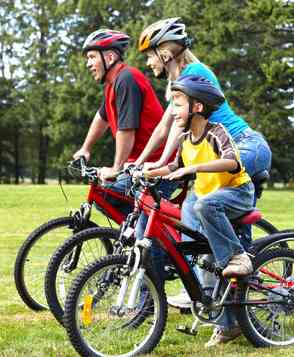- MENU
- HOME
- SEARCH
- WORLD
- MAIN
- AFRICA
- ASIA
- BALKANS
- EUROPE
- LATIN AMERICA
- MIDDLE EAST
- United Kingdom
- United States
- Argentina
- Australia
- Austria
- Benelux
- Brazil
- Canada
- China
- France
- Germany
- Greece
- Hungary
- India
- Indonesia
- Ireland
- Israel
- Italy
- Japan
- Korea
- Mexico
- New Zealand
- Pakistan
- Philippines
- Poland
- Russia
- South Africa
- Spain
- Taiwan
- Turkey
- USA
- BUSINESS
- WEALTH
- STOCKS
- TECH
- HEALTH
- LIFESTYLE
- ENTERTAINMENT
- SPORTS
- RSS
- iHaveNet.com: Health
January W. Payne

Find activities the whole family can do together, such as a daily walk or bike ride in the neighborhood
It's no secret that childhood obesity is a major issue in the United States. First Lady Michelle Obama has even devoted part of her agenda to fighting it.
At the core of the problem is the fact that less than one third of all children ages 6 to 17 get regular vigorous exercise, defined as at least 20 minutes of physical activity that makes them sweat and breathe hard, according to a new joint report from the
So what should parents do to get their kids moving more often? First, don't assume your child gets sufficient exercise in school through physical education classes, experts say. Most, but not all states require P.E., according to the new report. That means parents should incorporate physical activity into family time at home.
Here are 5 tips to get started:
1. Encourage a little bit at a time. Minutes spent playing kickball with friends during recess count toward the hour-long daily goal, as does climbing trees in the backyard after school. "It doesn't have to be all at once," says Nancy Brown, CEO of the AHA. "Kids should be doing things appropriate for their age, so that (exercise) becomes a behavior and a natural part of what they do."
2. Advocate for well-maintained, safe sidewalks and bike paths in your neighborhood, and volunteer to supervise the use of school facilities after hours. Children are more likely to want to play outside -- and you'll feel more comfortable with them doing it -- if it's safe, so attend neighborhood association or city council meetings to request proper upkeep of nearby sidewalks and paths.
Also, consider gyms and tracks at local schools as options for physical activity after hours and on weekends. Often, schools are willing to make gyms and equipment available on the weekends but simply need parents to volunteer to supervise, Brown says.
3. Practice what you preach. "We think that parents and other adult role models need to set an example by being active themselves," Brown says. And it's not hard to find activities the whole family can do together, such as a daily walk or bike ride in the neighborhood. Other simple but fun options: hide-and-seek, jump rope, tag, or a game of basketball in the driveway. Mowing the lawn, raking leaves, and shoveling snow count, too.
4. Don't underestimate the value of some video games. The AHA and
5. Don't let other activities or physical disabilities limit your child. Thirty-two states allow students to waive P.E. because of health issues, physical disabilities, religious beliefs, early graduation, or participation in other activities, such as cheerleading or marching band. But those kids -- even those with physical disabilities or health problems -- still need to get an hour or more of exercise per day, says Charlene Burgeson, executive director of the NASPE.
"Not being physically active isn't the way to go. If students have health issues or disabilities, there may be a way to modify the (physical) activity" to accommodate them, she says. "By not giving them that activity, we're really doing them an injustice." Solving this problem may mean approaching the school or gym teacher to ask how the class can be modified to accommodate your child.
Available at Amazon.com:
Healthy Travel: Don't Travel Without It!
The Good Doctor's Guide to Colds and Flu
Copyright © U.S. News and World Report. All rights reserved.
AGING | ALTERNATIVE | AILMENTS | DRUGS | FITNESS | GENETICS | CHILDREN'S | MEN'S | WOMEN'S
Health - Exercise for Kids: 5 Tips for Parents